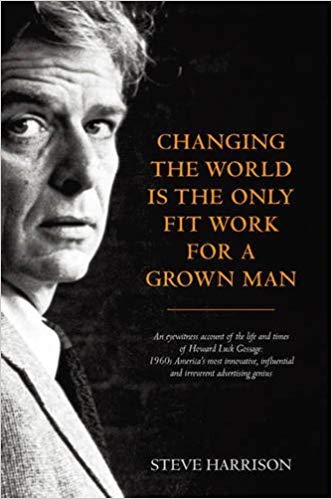The Real Mad Men
The stars of the “Mad Men” advertising era were David Ogilvy and Rosser Reeves (among others). Another advertising legend, though less well-known was Howard Luck Gossage. Gossage was the driving force behind the success of the advertising agency Weiner & Gossage (W&G) and he challenged the established norms and status quo of the advertising industry. Gossage was referred to as “The Socrates of San Francisco”.
In today’s world of online communities, viral news stories, and the blurring of real and fake news, the story of Howard Luck Gossage shows that everything new is really old. An advertising legend from the 1950s and 1960s Gossage changed the way the advertising industry operated. He was decades ahead of his peers in terms of building communities and spreading viral messages.
Howard Luck Gossage
In Steven Harrison’s excellent book Changing the World is the Only Fit Work for a Grown Man, Harrison provides a great deep-dive into the life of Gossage. Harrison follows Gossage from his beginnings to becoming one of the advertising industry stars. The book outlines the creative and innovative ways Gossage “zigged” when everyone else “zagged”.
Gossage was extremely demanding of his self. He changed the advertising landscape with his excellent marketing skills, along with being one of the top copy writers of his time. He wrote all the copy and headlines himself, and was not open to ideas or recommendations. He was headstrong, arrogant, and a master of public relations (PR); he set out to change the advertising industry. The goal of his work was to create an “event” that would generate ongoing publicity through various media.
He focused on creating stunts or spectacles that would be shared through multiple media. The objective of his advertising was to create successful propaganda. He wanted the original advertising message amplified. Unlike the larger agencies at the time, he avoided expensive mass-media and focused on creating a focused message to a targeted audience.
Big Ideas
Gossage felt headlines must generate headlines of its own. His conversationalist writing style pulled readers in and allowed them to feel as part of a family or community. The style was based on creating information loops; keep the conversation going - send out information, receive feedback, and repeat.
He felt an advertisement must have a big idea to catch someone’s attention. It needed to be simple, yet be impactful for other media to amplify the message. Mainstream press and broadcast media had to be seen as an integrated part of any communication plan.
W&G focused on being different not just in how it created advertisements, but how the agency operated as well. It was focused on being a large agency, it was about working on impactful projects to continuously create and innovate new ideas. Rather than bill clients based on the amount of media purchased, W&G charged based on work and ideas (upsetting many of the large agencies). Also, W&G avoided the trend to push advertising through a massive mainstream media buy.
Against the Grain
Most agencies focused on buying large amounts of mass media for an attrition-type advertising campaign. W&G focused on developing an impactful advertisement that pulled people in, created a conversation, and developed a community of like-minded people. The goal was to find the targeted group of people who were interested in the content. The majority of the successful campaigns was low-budget but centered on great headlines, copy, and design.
Unlike the larger, mainly white male agencies, W&G was small, only about 15-20 people. Located in a refurbished firehouse in San Francisco, W&G was racially diverse – women, Asians, blacks, etc. They focused on creating a learning environment and encouraged employees to continue their education and engage with diverse groups of people. The agency culture mirrored the changing times of the 1960s and the atmosphere within San Francisco. Celebrities, politicians, and business leaders frequented the firehouse.
The agency was the center of the changing culture and social environment of the 1960s. The firehouse became the nucleus for the exchange of new and radical ideas to challenge the status quo. W&G would sponsor speaking events creating a center for radical ideas and creating awareness of important events and people. For example, Gossage promoted Marshall McLuhan, creating a mainstream celebrity. The goal was not financial gain for Gossage (he did the work pro-bono), but getting McLuhan’s message and research to the mainstream.
Conclusion
Later in life Gossage focused on social and environmental issues. He applied his skills to radical causes, partnering with the Sierra Club and helping to create Friends of the Earth. Being in the center of the counter-culture of San Francisco in the 1960s, Gossage developed campaigns to save the Grand Canyon and Redwood Forests, and worked on creating a revolution in the small Caribbean island of Anguilla. Gossage felt advertising should be used for the greater good; large, important causes. He wanted to change the world.
He was a marketing genius who wrote amazing advertisements. He always focused on creating something new and exciting. He changed the way advertising agencies operated. A famous Gossage quote, “If you’re stuck with a lemon, make lemonade” epitomizes his mindset and spirit, to work incredibly hard to create change.
Further Reading
Reality in Advertising by Rosser Reeves
The Book of Advertising Tests; A Group of Articles that Actually Say Something About Advertising by Lord & Thomas
Confessions of an Advertising Man by David Ogilvy









